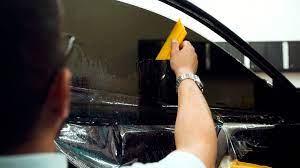The Ultimate Guide to Window Tinting: Benefits, Types, and Regulations
Window tinting is more than just a stylish addition to your vehicle or property; it offers numerous practical benefits, from reducing heat and glare to enhancing privacy and security. In this comprehensive guide, we’ll delve into the world of switchable film brooklyn ny, exploring its advantages, different types, and important regulations you need to know.
Benefits of Window Tinting:
- Heat Reduction: Window tinting helps to block out a significant portion of the sun’s heat, keeping the interior of your car or building cooler and reducing the need for excessive air conditioning. This can lead to lower energy costs and increased comfort, especially during hot summer months.
- UV Protection: Quality window tinting films can block up to 99% of harmful UV rays, which not only protects your skin from sun damage but also prevents fading and deterioration of upholstery, furniture, and other interior surfaces.
- Glare Reduction: Glare from the sun or headlights of other vehicles can be a major distraction and safety hazard while driving or working. Tinted windows reduce glare, improving visibility and reducing eye strain.
- Privacy and Security: Tinted windows provide an added layer of privacy by making it difficult for outsiders to see into your vehicle or property. This can deter potential thieves and intruders, enhancing your security and peace of mind.
- Enhanced Aesthetics: Window tinting can enhance the appearance of your vehicle or building, giving it a sleek, modern look. With a variety of tint shades and finishes available, you can customize the appearance to suit your preferences.
Types of Window Tinting:
- Dyed Window Tint: This type of tinting consists of a layer of dye between an adhesive layer and a protective outer layer. It is affordable and provides good heat and UV protection, but may fade over time.
- Metalized Window Tint: Metalized tinting contains tiny metallic particles that reflect heat and UV rays away from the window. It is more durable than dyed tinting and provides excellent heat rejection, but it may interfere with electronic signals.
- Carbon Window Tint: Carbon tinting contains carbon particles that block heat and UV rays without interfering with electronic signals. It offers superior heat rejection, color stability, and a sleek matte finish.
- Ceramic Window Tint: Ceramic tinting uses ceramic particles to block heat and UV rays while allowing maximum visibility and clarity. It is highly durable, non-conductive, and does not interfere with electronic signals, making it the premium choice for window tinting.
Regulations:
Before tinting your windows, it’s important to familiarize yourself with local regulations regarding tint darkness, reflectivity, and placement. These regulations vary from state to state and country to country, so be sure to check with your local authorities or a reputable tinting professional to ensure compliance.
Conclusion:
Window tinting offers a multitude of benefits, ranging from heat reduction and UV protection to enhanced privacy and security. By choosing the right type of tinting and adhering to local regulations, you can enjoy a more comfortable, safer, and stylish environment in your vehicle or property. Whether you’re looking to beat the heat, protect your belongings, or simply upgrade the aesthetics, window tinting is a versatile solution worth considering.
